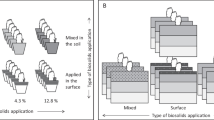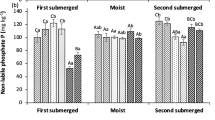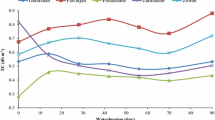Abstract
Purpose
The study examines if a short period of reaction after addition of biosolids to soils can reduce the solubility and potential phytotoxicity of biosolid-borne Zn and Cu.
Methods
The effects of period of aging (zero, 60, and 120 days) of biosolids (applied at 0, 10, 20, and 30 g kg−1) with an acid, neutral, or alkaline soil on pH and concentrations of Zn, Cu, and dissolved organic C in solution over a 60-day growth period of spinach were investigated using Rhizon pore water samplers.
Results
In the acid and neutral soils, increasing aging period markedly reduced the concentrations of Zn and Cu in solution and there were concomitant increases in solution pH. The effect was much less pronounced in the alkaline soil. Soluble Zn and Cu concentrations were generally positively correlated with dissolved organic C concentrations, negatively correlated with pH in the alkaline and neutral soils but positively correlated with pH in the acid soil. Spinach yields were lower in the acid than neutral and alkaline soils and tended to increase with increasing rates of biosolids in all three soils. The concentrations of tissue Zn and Cu were notably high in shoots of plants grown in the acid soil. For all biosolid-amended soils, the concentrations of tissue Cu were lower in plants grown after 60 days rather than no aging.
Conclusions
Following biosolids applications to soils, an aging period of only a few months is likely to lower the solubility, and potential phytotoxicity, of biosolid-borne Zn and Cu particularly in acid and neutral soils.





Similar content being viewed by others
References
Antoniadis V, Tsadilas CD, Stamatiadis S (2007) Effect of dissolved organic carbon on zinc solubility in incubated biosolids-amended soils. J Environ Qual 36:379–385
Bolan NS, Adriano D, Senesi N, Kunhikrishnan A, James T, McDowell R (2010) Dissolved organic carbon: biogeochemistry, dynamics and agro-environmental significance in soils. Adv Agron 110:1–75
Brunauer S, Emmett PH, Teller E (1938) Adsorption of gases in multimolecular layers. J Am Chem Soc 60:309–319
Environmental Protection Agency (EPA), South Australia (1996) South Australian Guidelines for Safe Handling and Reuse of Biosoilds. Adelaide, EPA South Australia
Epstein E (2003) Land application of sewage sludge and biosolids. Lewis, Boca Raton
Garcia C, Hernandez T, Costa F (1991) Changes in carbon fractions during composting and maturation of organic wastes. Environ Manage 15:433–439
Haynes RJ (2005) Labile organic matter fractions as central components of the quality of agricultural soils: an overview. Adv Agron 85:221–268
Haynes RJ, Murtaza G, Naidu R (2009) Inorganic and organic constituents and contaminants of biosolids: implications for land application. Adv Agron 104:165–267
Hooda PS, Alloway BJ (1993) Effects of time and temperature on the bioavailability of Cd and Pb from sludge-amended soils. J Soil Sci 44:97–110
Hooda PS, Alloway BJ (1994) The plant availability and DTPA extractability of trace metals in sludge-amended soils. Sci Total Environ 149:39–51
Hue NV (1995) Sewage sludge. In: Rechcigl JE (ed) Soil amendments and environmental quality. Lewis, Boca Raton, pp 199–247
Isbell RF (2002) The Australian soil classification. CSIRO Publishing, Collingwood
Kamprath EJ (1984) Crop response to lime on soils in the tropics. In: Adams F (ed) Soil Acidity and Liming. American Society of Agronomy, Madison, pp 349–368
Khaleel R, Reddy KR, Overcash MR (1981) Changes in soil physical properties due to organic waste applications: a review. J Environ Qual 10:133–141
Knight BP, Chaudri AM, McGrath SP, Giller KE (1998) Determination of chemical availability of cadmium and zinc in soils using inert soil moisture samplers. Environ Pollut 99:293–298
Ma Y, Lombi E, Oliver IW, Nolan AL, McLaughlin MJ (2006) Long-term aging of copper added to soils. Environ Sci Technol 40:6310–6317
Macnicol RD, Beckett PHT (1985) Critical tissue concentrations of potentially toxic elements. Plant Soil 85:107–129
Martinie GD, Schilte AA (1976) Investigation of the wet oxidation efficiencies of perchloric acid mixtures for various organic substances and the identities of residual matter. Anal Chem 48:70–74
McBride MB (2000) Chemisorption and precipitation reactions. In: Sumner ME (ed) Handbook of soil science. CRC Press, Boca Raton, pp B265–B302
McBride MB, Richards BK, Steenhuis T, Spiers G (1999) Long-term leaching of trace elements in a sludge-amended silty clay loam. Soil Sci 164:613–623
McGrath SP (1987) Long-term studies of metal transfers following application of sewage sludge. In: Coughtrey PJ, Martin LH, Unsworth MH (eds) Pollutant transport and fate in ecosystems, Special Publ. No 6 of the British Ecological Society. Blackwell Scientific, Oxford, pp 301–317
Meijboom F, van Noordwijk M (1991) Rhizon soil solution samplers as artificial roots. In: Kutschera L, Huebl E, Lichtenegger E, Persson H, Sobotnik M (eds) Root ecology and its practical application, 3 ISRR Symposium Verein fur Wurzelforschung, A-9020. Klagenfurt, Austria, pp 793–795
Miller WP, Miller DM (1987) A micro-pipette method for soil mechanical analysis. Commun Soil Sci Plant Anal 18:1–15
Mukherjee A, Mishra VK (2008) Bioaccumulation of heavy metals in crops irrigated with secondary treated sewage waste water in surrounding villages of Varanasi city. Res Environ Life Sci 1:103–108
Murtaza G, Haynes RJ, Naidu R, Belyaeva ON, Kim KR, Lamb DT, Bolan NS (2011) Natural attenuation of Zn, Cu, Pb and Cd in three biosolids-amended soils of contrasting pH measured using Rhizon pore water samplers. Water Air Soil Pollut. doi:10.1007/s11270-011-0795-8
Pahlsson A-MB (1989) Toxicity of heavy metals (Zn, Cu, Cd, Pb) to vascular plants. A literature review. Water Air Soil Pollut 47:287–319
Rayment GE, Higginson FR (1992) Australian laboratory handbook of soil and water chemical methods. Inkata Press, Melbourne
Sastre J, Sahuquillo A, Vidal M, Rauret G (2002) Determination of Cd, Cu, Pb and Zn in environmental samples: microwave-assisted total digestion versus aqua regia and nitric acid extraction. Anal Chim Acta 462:59–72
Schwab P, Zhu D, Banks MK (2007) Heavy metal leaching from mine tailings as affected by organic amendments. Bioresour Technol 98:2935–2941
Shaw RJ (1999) Soil salinity—electrical conductivity and chloride. In: Peverill KI, Sparrow LA, Reuter DJ (eds) Soil Analysis: an Interpretive Manual. CSIRO Publishing, Victoria, pp 129–145
Stacey S, Merrington G, McLauglin MJ (2001) The effect of aging biosolids on availability of cadmium and zinc in soil. Eur J Soil Sci 52:313–321
Tye AM, Young SD, Crout NMJ, Zhang H, Preston S, Barbosa-Jefferson VL, Davison W, McGrath SP, Paton GI, Kilham K, Resende L (2003) Predicting the activity of Cd2+ and Zn2+ in soil pore water from the radio-labile metal fraction. Geochim Cosmochim Acta 67:375–385
USEPA (2005) Test methods for evaluating solid waste, physical/chemical methods, SW-846. U S Government Printing Office, Washington, DC
Walter I, Martinez F, Alonso L, de Gracia J, Cuevas G (2002) Extractable soil heavy metals following the cessation of biosolids application to agricultural soil. Environ Pollut 117:315–321
WHO/FAO (2007) Joint FAO/WHO Food Standard Programme Codex Alimentaris Commission 13th Session
Author information
Authors and Affiliations
Corresponding author
Additional information
Responsible editor: Vera Slaveykova
Rights and permissions
About this article
Cite this article
Murtaza, G., Haynes, R.J., Kim, KR. et al. Effect of aging biosolids with soils of contrasting pH on subsequent concentrations of Cu and Zn in pore water and on their plant uptake. Environ Sci Pollut Res 19, 636–645 (2012). https://doi.org/10.1007/s11356-011-0592-3
Received:
Accepted:
Published:
Issue Date:
DOI: https://doi.org/10.1007/s11356-011-0592-3




